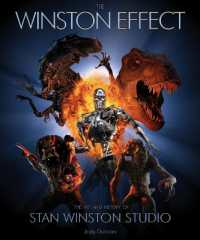- ホーム
- > 洋書
- > 英文書
- > Science / Mathematics
Full Description
Digital elements such as signal processors, microcontrollers or industrial PCs are widely used for filtering and control of continuous-time processes or plants. Because of the serial operation mode of these digital elements the continuous time processes cannot be served continuously. That is why continuous-time and discrete-time signals occur simultaneously in systems of this kind. The continuous (real) time also contains the discrete time instants - therefore, a complete and accurate description of such systems in continuous time is pos sible. However, this description proves to be more complicated, because the hybrid system becomes time-variable, also in cases, where all continuous-time processes and all digital elements are time invariant. Often digital elements operate with a fixed time period T, that leads to a periodically time-variable system. Besides the time sampling the use of analogue to digital and digital to analogue converters together with the finite numerical precision of the processors also results in amplitude quantization of the measuring and control signals. Taking into account these effects would lead to nonlinear models. Because these effects are often of minor influence but difficult in handling, in theory and practice it is generally accepted to consider mainly the pure time-quantization effect. Systems containing both continuous-time and discrete-time signals are usually called sampled-data systems (SD systems).
Contents
I Operational transformations of functions of continuous and discrete arguments.- 1 Bilateral Laplace transforms.- 2 Operational transformations for discrete-time functions.- 3 Displaced pulse frequency response.- 4 Discrete LT for functions of a continuous argument.- II Linear periodic operators and systems.- 5 Linear time-invariant operators and systems.- 6 Linear periodic operators and systems.- 7 Analysis of linear periodic operators and systems.- 8 Stochastic analysis and H2-norm of LPO.- III Mathematical description of sampled-data systems in continuous time.- 9 Open-loop SD systems.- 10 Open-loop systems with a computer.- 11 Closed-loop systems with a single sampling unit.- 12 Systems with several sampling units.- IV Analysis of SD systems in continuous time.- 13 Open-loop systems under deterministic disturbances.- 14 Analysis of deterministic feedback SD systems.- 15 Analysis of SD systems under stochastic disturbances.- V Direct synthesis of SD systems.- 16 Quadratic optimization of open-loop SD systems.- 17 Direct design of feedback SD systems.- 18 Direct polynomial-design methods.- Appendices.- A Rational periodic functions.- A.1 Basic definitions.- A.2 Causal and limited rational periodic functions.- A.3 Zeros and poles of rational periodic functions.- A.4 Partial fraction expansion of limited rational periodic functions.- A.5 Boundedness of rational periodic functions.- A.6 Calculating integrals from rational periodic functions.- A.7 Integration of products of rational periodic functions.- A.8 Calculation of parameter integrals.- B DirectSD — a toolbox for direct design of SD systems.- B.1 Introduction.- B.2 Theoretical basis.- B. System description.- B.4 Optimal control under stochastic disturbances.- B.4.1 Optimal digital filtering.- B.5 Design of optimal tracking systems.- B.5.1 One degree of freedom systems.- B.5.2 Systems with two controllers.- B.6 Other possibilities.- B.6.1 Analysis of SD systems in continuous time.- B.6.3 Demonstration programs.- B.7 Numerical examples.- B.7.1 Design of optimal stabilizing system.- B.7.2 Redesign problem.- B.8 Conclusions.








